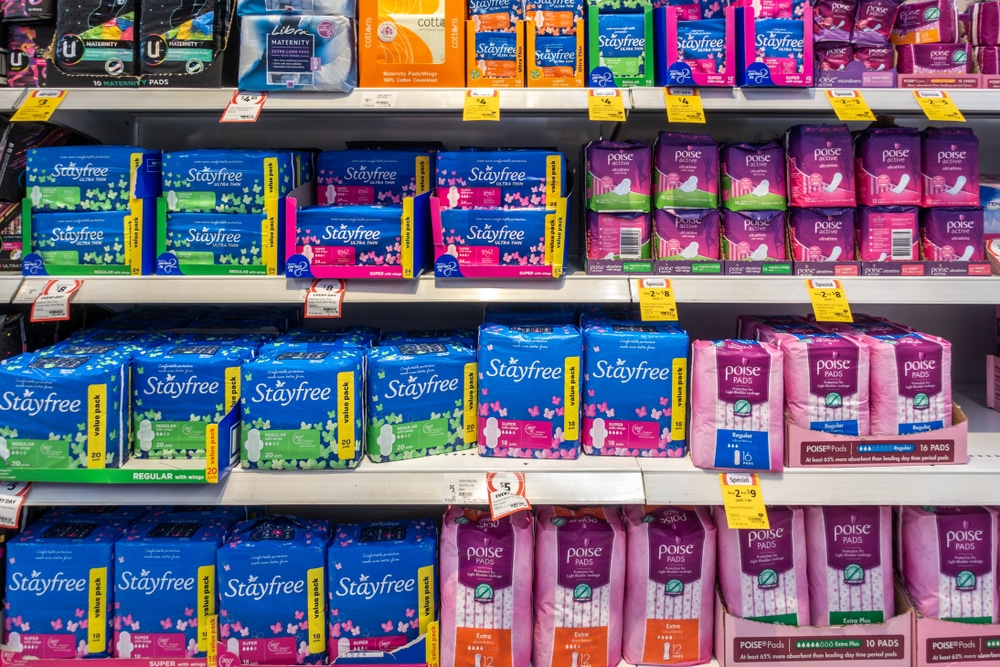More than two thirds of Australians have struggled to purchase period products in the last 12 months, a new report has found.
Today, Share The Dignity releases results from The Bloody Big Survey, the world’s largest survey on experiences, attitudes and insights on menstruation in Australia in the last 12 months. The researchers from data science social enterprise WhyHive, as well as report author Dr Jane Connory of Swinburne University of Technology, heard from more than 153,000 people who menstruate.
While Share the Dignity founder Rochelle Courtenay was hoping for a drop in levels of period poverty in Australia since the last survey in 2021, this year’s survey revealed the opposite: 64 per cent of Australians who menstruate have found it difficult to afford period products in the last 12 months.
In fact, close to 30 per cent have worn a tampon for more than the recommended four hours due to the cost of period products.
“I have seen so many stories shared through the survey about people’s experiences with period poverty, with some people having used tea towels, or tote bags to try and manage their period with dignity, which is unacceptable here in Australia,” Rochelle Courtenay from Share The Dignity said.
“The Bloody Big Survey is vital to ensure we have the data to validate every heartbreaking experience we have heard with period poverty since we started nine years ago so we can advocate for change.”

Who is experiencing period poverty?
Period poverty happens people who menstruate are unable to afford menstrual products such as pads, tampons, menstrual cups and period underwear.
It is the result of Australia’s cost-of-living crisis, intergenerational poverty and disadvantage, among several other social issues.
Australia’s underrepresented communities are experiencing period poverty at disproportionate rates, including First Nations peoples, the LGBTQIA+ and gender diverse communities, and people with disabilities.
More than 80 per cent of Aboriginal and/or Torres Strait Islander people have struggled to afford period products, while 21.5 per cent have not been able to afford products at all.
Meanwhile, 83 per cent of gender-diverse people are experiencing period poverty, and 78 per cent of people with a disability have found it difficult to purchase period products.
Rochelle Courtenay noted that, as the cost-of-living crisis is affecting more and more people in Australia, period poverty is not just impacting low-income earners and marginalised communities.
“We asked people for their household income in the survey, and this is not just a problem that you would expect in people with incomes under $70,000 a year,” Courtenay told Women’s Agenda.
“This is happening even for people who have got incomes in that $200,000+ bracket.”
While 23 per cent of respondents (1,316 respondents) whose household income is $0 – $19,999 are experiencing period poverty, more than 400 people who have a household income over $200,000 a year (1.6 per cent of respondents) said they have been unable to afford period products.
What is the impact?
Period shame and stigma causes serious impacts on the health, wellbeing, education and financial stability of women and girls.
More than half (56 per cent) of respondents said they have had to miss work because of their period, while 63 per cent said they have missed school, and 68 per cent said they have missed sport.
One in three respondents who missed work because of their period said it was due to a fear of leaking, and more than three quarters (76.5 per cent) who missed sport said the same.
Courtenay said the problem of fear of leaking has a simple solution: providing free period products in workplaces, schools, sports facilities and other community spaces.
“It should be standard, like toilet paper,” Courtenay said.
“What I want moving forward is better outcomes for girls and women, whether they’re at sport, whether they’re at work, or whether they’re trying to get an education.
“We’re not asking very much. We’re just asking for equity.”
What’s being done?
Governments around Australia have put measures in place in response to period poverty. Every state and territory in Australia provides at least state high schools with period products for students to access at no cost. Victoria was the first state to do so in 2019, and WA was the latest state government to provide free period products for students in state primary schools.
The federal government has also taken action. In 2019, thanks to lobbying from organisations like Share The Dignity, the government scrapped the goods and services tax (GST) from menstrual products. The tax on period products cost taxpayers who menstruate $30 million a year, and removing the GST from these products resulted in approximately a 9.1 per cent reduction in the retail shelf price, according to the ACCC.
More recently, the Australian government pledged an investment of $12.5 million over the next four years in the 2024-25 federal budget, to improve access to menstrual products for First Nations women and girls who experience higher rates of period poverty.
But Courtenay from Share The Dignity said there needs to be more efforts from local councils, sport clubs and other community spaces to provide access to period products cost-free for women and girls.
Workplaces also have a role to play: The Bloody Big Survey estimates that employees missing work due to their periods costs Australian businesses approximately $9.6 billion annually.
Courtenay said a cost-benefit analysis would show the positive impact of providing free period products in these spaces would outweigh the upfront cost.
“I don’t think costs should come into this,” Courtenay said.
“This is about equity. This is about making sure that we can all run the same race as each other.”

